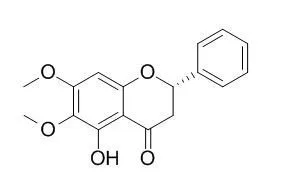| In vitro: |
| Phytomedicine. 2014 Oct 15;21(12):1651-7. | | Cytotoxicity and modes of action of 4'-hydroxy-2',6'-dimethoxychalcone and other flavonoids toward drug-sensitive and multidrug-resistant cancer cell lines.[Pubmed: 25442273] | Resistance of cancer to chemotherapy is a main cause in treatment failure. Naturally occurring chalcones possess a wide range of biological activities including anti-cancer effects. In this work, we evaluated the antiproliferative activity of three chalcones [4'-hydroxy-2',6'-dimethoxychalcone (1), cardamomin (2), 2',4'-dihydroxy-3',6'-dimethoxychalcone (3)], and four flavanones [(S)-(-)-pinostrobin (4), (S)-(-)-Onysilin (5) and alpinetin (6)] toward nine cancer cell lines amongst which were multidrug resistant (MDR) types.
METHODS AND RESULTS:
The resazurin reduction assay was used to detect the antiproliferative activity of the studied samples whilst flow cytometry for the mechanistic studies of the most active molecule (1).
IC50 values in a range of 2.54 μM against CEM/ADR5000 leukemia cells to 58.63 μM toward hepatocarcinoma HepG2 cells were obtained with 1. The lowest IC50 values of 8.59 μM for 2 and 10.67 μM for 3 were found against CCRF-CEM cells leukemia cells, whilst the corresponding values were above 80 μM for 4 and 6. P-glycoprotein-expressing and multidrug-resistant CEM/ADR5000 cells were much more sensitive toward compound 1 than toward doxorubicin and low cross-resistance or even collateral sensitivity was observed in other drug-resistent cell lines to this compound. Normal liver AML12 cells were more resistant to the studied compounds than HepG2 liver cancer cells, indicating tumor specificity at least to some extent. Compound 1 arrested the cell cycle between Go/G1 phase, strongly induced apoptosis via disrupted mitochondrial membrane potential (MMP) and increased production of reactive oxygen species (ROS) in the studied leukemia cell line.
CONCLUSIONS:
Chalcone 1 was the best tested cytotoxic molecule and further studies will be performed in order to envisage its possible use in the fight against multifactorial resistant cancer cells.
| | Chin Med. 2010 May 13;5:17. | | Isolation and identification of bioactive compounds in Andrographis paniculata (Chuanxinlian).[Pubmed: 20465823] | Andrographis paniculata (Burm. f.) Nees (Acanthaceae) is a medicinal plant used in many countries. Its major constituents are diterpenoids, flavonoids and polyphenols.
METHODS AND RESULTS:
Among the single compounds extracted from A. paniculata, andrographolide is the major one in terms of bioactive properties and abundance. Among the andrographolide analogues, 14-deoxy-11,12-didehydroandrographolide is immunostimulatory, anti-infective and anti-atherosclerotic; neoandrographolide is anti-inflammatory, anti-infective and anti-hepatotoxic; 14-deoxyandrographolide is immunomodulatory and anti-atherosclerotic. Among the less abundant compounds from A. paniculata, andrograpanin is both anti-inflammatory and anti-infective; 14-deoxy-14,15-dehydroandrographolide is anti-inflammatory; isoandrographolide, 3,19-isopropylideneandrographolide and 14-acetylandrographolide are tumor suppressive; arabinogalactan proteins are anti-hepatotoxic.
CONCLUSIONS:
The four flavonoids from A. paniculata, namely 7-O-methylwogonin, apigenin, Onysilin and 3,4-dicaffeoylquinic acid are anti-atherosclerotic. |
|






 Cell. 2018 Jan 11;172(1-2):249-261.e12. doi: 10.1016/j.cell.2017.12.019.IF=36.216(2019)
Cell. 2018 Jan 11;172(1-2):249-261.e12. doi: 10.1016/j.cell.2017.12.019.IF=36.216(2019) Cell Metab. 2020 Mar 3;31(3):534-548.e5. doi: 10.1016/j.cmet.2020.01.002.IF=22.415(2019)
Cell Metab. 2020 Mar 3;31(3):534-548.e5. doi: 10.1016/j.cmet.2020.01.002.IF=22.415(2019) Mol Cell. 2017 Nov 16;68(4):673-685.e6. doi: 10.1016/j.molcel.2017.10.022.IF=14.548(2019)
Mol Cell. 2017 Nov 16;68(4):673-685.e6. doi: 10.1016/j.molcel.2017.10.022.IF=14.548(2019)